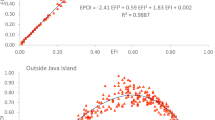Abstract—
The article examines the influence of ethno-linguistic diversity on the rate of economic growth in the regions of the Russian Federation. The empirical results obtained confirm that ethnic diversity supports economic growth and that elasticities of growth rates with respect to the initial level of diversity differ by region and time period and depend both on the indices of ethnolinguistic fractionalization themselves and on the initial level of per capita income in the region. From the standpoint of the theoretical model, it can be concluded that there is an optimal level of ethnic diversity, as well as that this level, determined by the parameters of the population’s tolerance towards representatives of other ethnic groups, as well as the share of rent in income, has not been achieved in any of the Russian regions.


Similar content being viewed by others
Notes
From English “social planner.”
It is clear that this consideration of bargaining for resources is broader than interethnic competition, but certain parallels can be drawn, especially in the light of subsidies received by many national jurisdictions around the world in various forms.
In the English-speaking tradition of “bargaining power.”
From English “social planner.”
Calibration of the parameters of this model is not very useful, since it is built under the simplifying assumption that all groups are equal in size. However, based on empirical analysis, it can be assumed that the parameter on average for the regions is 0.20–0.24.
This index is also known as the Elf-index, i.e., index of ethno-linguistic fractionalization. We also use the term “diversification index.”
This is quite clearly seen from the statistics published by Rosstat on GRP and actual consumption of the population and subjects of the Federation.
REFERENCES
W. Easterly and R. Levine, “Africa’s growth tragedy: policies and ethnic divisions,” Quart. J. Econ. 112 (4), 1203–1250 (1997). https://doi.org/10.1162/003355300555466
G. Tullock, “The welfare cost of tariffs, monopolies, and theft,” West. Econ. J. 5, 224–232 (1967).
K. Desmet, M. Breton, I. Ortuno-Ortin, and S. Weber, Nation Formation and Genetic Diversity, Center for Operations Research and Econometrics Discussion Paper, no. 2006/95, 2006.
A. N. Bufetova, E. A. Kolomak, and M. M. Mikhaleva, “National diversity and economic development of Russian regions,” Mir Ekon. Upr. 17 (3), 143–157 (2017). https://doi.org/10.25205/2542-0429-2017-17-3-143-157
A. N. Bufetova and E. A. Kolomak, “National heterogeneity in the regions of Russia: assessment, change, impact on economic development,” Vopr. Ekon., No. 1, 120–142 (2021). https://doi.org/10.32609/0042-8736-2021-1-120-142
N. Campos and V. Kuzeyev, “On the dynamics of ethnic fractionalization,” Am. J. Polit. Sci. 51 (3), 620–639 (2007).
A. Alesina, A. Devleeschauwer, W. Easterly, S. Kurlat, R. Wacziard, “Fractionalization,” J. Econ. Growth 8 (2), 155–94 (2003).
A. Alesina, J. Harnoss, and H. Rapoport, Birthplace Diversity and Economic Prosperity, National Bureau of Economic Research Working Paper, no. 18699, 2013. https://doi.org/10.3386/w18699
T. Vanhanen, “Domestic ethnic conflict and ethnic nepotism: a comparative analysis,” J. Peace Res. 36 (1), 55–73 (1999).
A. Alesina and E. La Ferrara, “Ethnic diversity and economic performance,” J. Econ. Liter. 43, 762–800 (2005).
S. Michalopoulos and E. Papaioannou, “National institutions and subnational development in Africa,” Quart. J. Econ. 129 (1), 151–213 (2014).
J. Montalvo and M. Reynal-Querol, Ethnic Diversity and Growth: Revisiting the Evidence, Economics Working Paper Series, Working Paper no. 1585, 2017.
N. Lee, “Migrants and ethnic diversity, cities and innovations: firm effect of city effects?,” J. Econ. Geogr. 15 (4), 1–28 (2014).
A. Alesina, J. Harnoss, and H. Rapoport, “Birthplace diversity and economic prosperity,” J. Econ. Growth 21 (2), 101–138 (2016).
L. E. Limonov and M. V. Nesena, “Features of the ethnocultural diversity of Russian regions,” Reg.: Ekon. Sotsiol., No. 3 (87), 146–170 (2015). https://doi.org/10.15372/REG20150906
L. E. Limonov and M. V. Nesena, “Cultural diversity of russian regions and economic growth,” Obshchestv.Nauki Sovrem., No. 1, 63–79 (2016).
W. Easterly, “Can institutions resolve ethnic conflict?,” Econ. Dev. Cult. Change 49 (4), 687–706 (2001).
A. Alesina, S. Michalopoulos, and E. Papaioannou, “Ethnic inequality,” J. Polit. Econ. 124 (2), 428–488 (2016).
J. Bluedorn, “Can democracy help? Growth and ethnic divisions,” Econ. Lett. 70 (1), 121-26 (2001).
E. Lazear, “Globalisation and the market for team-mates,” Econ. J. 109 (454), 15–40 (1999a).
E. Lazear, “Culture and language,” J. Polit. Econ. 107 (6), 95–126 (1999b).
G. Ottaviano and G. Peri, “Cities and cultures,” Nota di Lavoro, No. 92 (2004).
N. I. Suslov, “Optimal diversity in the socio-economic system: formal aspects” in IX Moscow International Operations Research Conference (MAKS Press, Moscow, 2018), pp. 229–233.
B. Baltagi, Econometric Analysis of Panel Data (Wiley, Ltd, Chichester, 2005).
M. Arellano and S. Bond, “Some tests of specification for panel data: Monte Carlo evidence and an application to employment equations,” Rev. Econ. Stud. 58, 277–297 (1991).
N. I. Suslov and E. N. Mel’tenisova, “Analysis of the impact of rising energy prices on the size of the shadow economy in the countries of the world,” Zh. Nov. Ekon. Assots, No. 3, 12–43 (2015).
Funding
The study was supported by grant 19-010-00731A “Comprehensive analysis of the heterogeneity of Russian regions and assessment of its impact on socio-economic development”.
Author information
Authors and Affiliations
Corresponding author
Rights and permissions
About this article
Cite this article
Suslov, N.I., Isupova, E.N. & Ivanova, A.I. Ethnic Diversity in Russian Regions and Economic Growth: Theoretical Model and Its Approbation on Panel Data. Stud. Russ. Econ. Dev. 33, 149–156 (2022). https://doi.org/10.1134/S1075700722020149
Received:
Revised:
Accepted:
Published:
Issue Date:
DOI: https://doi.org/10.1134/S1075700722020149




